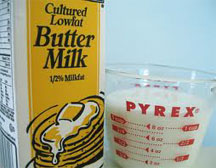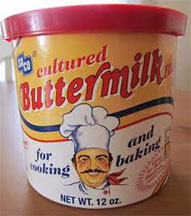What IS Buttermilk, Anyway?
By Alice Osborne
 Lots of great muffin, cake, and cookie recipes call for buttermilk. But have you ever wondered what it actually IS? And by the way, does it really contain butter?
Lots of great muffin, cake, and cookie recipes call for buttermilk. But have you ever wondered what it actually IS? And by the way, does it really contain butter?
Many folks do think that buttermilk is basically a buttery, high-fat milk. This couldn't be farther from the truth, however.
 There is no butter, per se, in buttermilk, and it is lower in fat than sweet milk. Old-fashioned homemade buttermilk is the slightly sour, residual liquid which remains after butter is churned, ie. milk from the butter or buttermilk. It was usually flecked with tiny spots of sweet, creamy butter that did not quite make it to the top to be skimmed.
There is no butter, per se, in buttermilk, and it is lower in fat than sweet milk. Old-fashioned homemade buttermilk is the slightly sour, residual liquid which remains after butter is churned, ie. milk from the butter or buttermilk. It was usually flecked with tiny spots of sweet, creamy butter that did not quite make it to the top to be skimmed.
 The flavor of buttermilk is reminiscent of yogurt and most people prefer it well-chilled. It is slightly thicker in texture than regular milk but not as heavy as cream. And here's a fun fact to know and tell at the dinner table: It takes 1 gallon of milk to yield 1/2 pint of true buttermilk.
The flavor of buttermilk is reminiscent of yogurt and most people prefer it well-chilled. It is slightly thicker in texture than regular milk but not as heavy as cream. And here's a fun fact to know and tell at the dinner table: It takes 1 gallon of milk to yield 1/2 pint of true buttermilk.
Nowadays, most commercial buttermilk is made by adding a lactic acid bacteria culture to pasteurized sweet whole milk, or more commonly, to skim milk or non-fat milk; it may or may not have added butter flecks. After the addition of the culture, the milk is left to ferment for 12 to 14 hours at a low temperature (optimum 69 degrees F.). It is usually labeled cultured buttermilk and may be salted or unsalted. Most commercial varieties are salted, so check the label if you are on a sodium-restricted diet.
 Now back to those recipes that call for buttermilk. What do you do if you start making a batch of muffins, for instance, and you realize, "Dang, this recipe calls for buttermilk and I don't have any!"? You have a couple choices. First, you can make a very good facsimile. All you need to do is add 1 tablespoon of vinegar to 1 cup of milk or cream. Let it sit several minutes so it can curdle. That's all - perfectly good "buttermilk" that will work in any recipe that calls for it.
Now back to those recipes that call for buttermilk. What do you do if you start making a batch of muffins, for instance, and you realize, "Dang, this recipe calls for buttermilk and I don't have any!"? You have a couple choices. First, you can make a very good facsimile. All you need to do is add 1 tablespoon of vinegar to 1 cup of milk or cream. Let it sit several minutes so it can curdle. That's all - perfectly good "buttermilk" that will work in any recipe that calls for it.
 OR, you can mix buttermilk powder into the dry ingredients of your recipe, and then add the recommended amount of liquid the recipe calls for. (A conversion table is on the back of the container.)
OR, you can mix buttermilk powder into the dry ingredients of your recipe, and then add the recommended amount of liquid the recipe calls for. (A conversion table is on the back of the container.)
Most often I use the vinegar and milk method because I don't usually have buttermilk powder in my pantry. I've had perfect success with this. There are some things though, that make it worthwhile to have the real McCoy around - buttermilk icing or buttermilk pie, for instance. But it's always good to have a back-up plan, don't you think?

